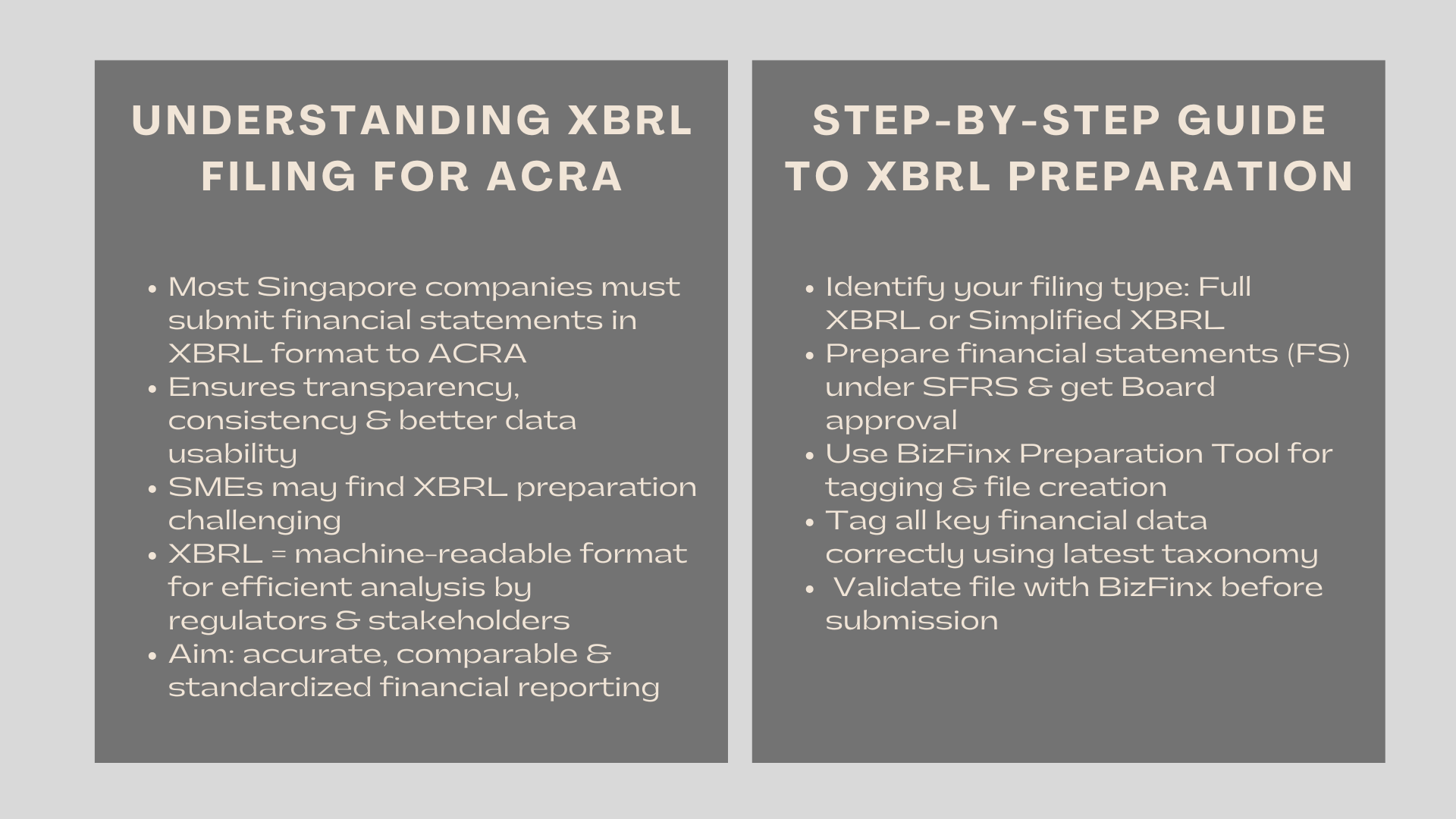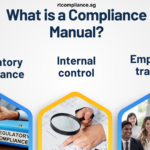Step-by-Step Guide to Preparing XBRL Statements for ACRA
Businesses in Singapore are mandated to submit their annual financial accounts in the XBRL (eXtensible Business Reporting Language) format as a part of their annual submissions to Accounting and corporate regulatory Authority (ACRA). This online reporting system will improve the level of financial transparency, provide consistency, and enable ACRA to handle corporate data in a more efficient way.
Although the advantages are obvious, the XBRL preparation and filing process is still complicated to many businesses, particularly the small and medium-sized enterprises (SMEs). In order to make it easy, this paper gives you a step by step process that will see you fill your filing correctly and punctually, especially for companies where teams may benefit from additional financial knowledge such as those who may attend a finance course for non-finance managers Singapore.

Introduction to XBRL and Its Use.
XBRL is a universal standard of business information exchange. It allows financial information to be marked with a computer which facilitates easy interpretation and analysis by regulators, investors and auditors. XBRL filing is required in Singapore by most companies which are limited by share, and not by exempted entities such as those which lack public accountability, and small and inactive companies.
The main aim of XBRL filing is to make corporate financial data transparent, comparable and consistent in an industry. It also simplifies the procedure of both ACRA and companies to minimize the number of manual errors and accelerate the review and benchmarking.
Step 1: Determine Your Filing Requirements
The first step in the stepwise process for XBRL filing compliance in Singapore is determining whether your company is required to file in full XBRL format or in simplified XBRL format. ACRA has given particular filing requirements depending on the type of company, size, and the financial reporting requirements.
All companies required to prepare a full file of XBRL of financial statements usually do so under the Singapore Financial Reporting Standards (SFRS). Other entities with simple financial structure or smaller can be subjected to simplified filing. To prevent compliance errors, it is necessary to examine the current filing requirements issued by ACRA before initiating the process.
Step 2: prepare statements of your money.
After confirming a type of filing, prepare your financial statements based on standards used to prepare such statements. Your finances have to contain:
- Statement of financial position (balance sheet)
- Profit or loss statement and the other comprehensive income statement.
- Statement of cash flows
- Changes of equity statement.
- Notes to the accounts
Your company directors should finalize and approve these reports then convert them to an XBRL format. Make sure that the data is correct and is similar throughout all parts because inconsistency will slow the approval or lead to rejection.
Step 3: BizFinx Preparation Tool.
ACRA offers a free on-line system, the BizFinx Preparation Tool, where companies create and certify XBRL files. Get the updated edition of the software on the official site of ACRA and make sure that it is compatible with your system.
Click so that you upload your completed financial statements in the tool and begin tagging your information fields in line with the taxonomy of ACRA. Taxonomy forms the standard format and terminology that is applied in XBRL so that reporting is standardized.
Although the tagging process might seem to be technical, ACRA also provides comprehensive guides and sample templates to enable users navigate through the process with ease.
Step 4: Tag Key Data Elements
Tagging is one of the most critical steps in how to prepare XBRL financial statements for ACRA submission. Each figure or disclosure item must be assigned a specific tag that corresponds to the relevant accounting term.
As an example, in the XBRL taxonomy, the total assets, revenue, and net profit each have the assigned tags. The idea is to make sure that whoever reads your XBRL report whether they are an investor or a regulator can easily locate and match these data points.
Be particularly careful when marking notes and disclosures which tend to be qualitative data. Poor tagging or leaving out fields might result in incomplete filings, and this may be rejected or penalised.
Step 5: Validate the XBRL File
Once data fields have been tagged, the built-in validation option will allow one to verify errors posted by the BizFinx Tool. The tool automatically detects inconsistencies that could be missing data, non-conformity of formats, or mismatch of calculators.
It is best that you attempt to resolve these problems prior to submission in order to have your file comply with the requirements of ACRA. The validation also assures that your report is based on the right taxonomy version that is updated every time as the financial reporting standards are modified.
Step 6: Pre-submission Review.
Conduct an extensive review of your XBRL file before it is finally submitted. Make a comparison of the tagged information with your original financial statements to make sure they are correct. Be attentive to such financial values as revenue, profit, and total equity.
Another person that might be interested in review of the draft XBRL file is the company accountant or auditor. Their experience can aid in uncovering small mistakes which are not specifically emitted by automated validation programs, like misconstrued improperly documented notes.
Step 7: Submit XBRL File to ACRA.
After validating and reviewing, file your XBRL financial statements using BizFile plus portal of ACRA. You will be required to provide your CorpPass credentials, or an authorized filing agent of your company, in order to go through the process.
Once submissions are done, you will get an acknowledgement of ACRA. It is also important to keep a copy of the confirmation and the file submitted relating to XBRL in the records of your company since these might be needed in case of an audit or review.
Step 8: Decrease Filing Inconsistencies.
The important element of compliance is consistency. Keep well-organized records and prepare financial statements the format which would be adopted by ACRA taxonomy during the year. This will make your subsequent filing a lot easier and would make any changes in the taxonomy or filing rules easily implemented.
This can be further simplified by the companies that embrace the accounting software that has the built in XBRL generation capabilities. These tools have the benefit of automating tagging and validation and save on time and risk of manually handling the data.
Common Mistakes to Avoid
The most common filing mistake is to use older versions of BizFinx Tool or taxonomy. There are cases of companies neglecting ACRA update thus they end up with validation errors or rejections.
Incorrect tagging is another frequent problem–especially when the companies hurry in the process without the knowledge of each data field. Rather than spend money on expensive lost time or fines, it is preferable to spend time tagging and reading.
Last but not least, make certain that the financial statements are precisely what has been endorsed by your board. Whenever there are inconsistencies between the original and the XBRL version, there might arise some compliance problems in case of audit.
Most effective Filing Best Practices.
Your XBRL submission will be easier when you maintain your bookkeeping on an annual basis. Do not leave the task of data reconciliation and report preparation till the very end.
Think about training your financial department on the XBRL, or have it done by a team of professional that are specialized in making ACRA-compliant filings. XBRL conversion and review services are available at affordable costs with many firms offering such services and this can save a lot of time and effort among SMEs.
The other tool that will prove handy is the adoption of accounting software that has been XBRL-compatible exports. This reduces the number of hands that have to be employed, is more accurate and it makes your business remain in line with changing regulations.
Conclusion to Step-by-Step Guide to Preparing XBRL Statements for ACRA
It might look very hard to file correct and compliant XBRL statements initially but after having the procedure and a systematic approach under hand it becomes very easy. Through the correct tools, sound accounting, and sound validation of your data, your company will be able to eliminate expensive errors and stay out of trouble with ACRA.
Learning how to prepare XBRL financial statements to submit it to ACRA and how to perform a step-by-step process of XBRL filing compliance in Singapore, businesses will be able to simplify their financial reporting, increase its accuracy, and make sure that they comply with the regulatory framework in Singapore in due time.




